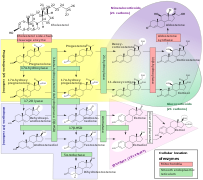3β-Hydroxysteroid dehydrogenase
| 3β-hydroxysteroid dehydrogenase/Δ-5-4 isomerase | |||||||||
|---|---|---|---|---|---|---|---|---|---|
| Identifiers | |||||||||
ExPASy | NiceZyme view | ||||||||
| KEGG | KEGG entry | ||||||||
| MetaCyc | metabolic pathway | ||||||||
| PRIAM | profile | ||||||||
| PDB structures | RCSB PDB PDBe PDBsum | ||||||||
| Gene Ontology | AmiGO / QuickGO | ||||||||
| |||||||||
| 3β-Hydroxysteroid dehydrogenase | |||||||||
|---|---|---|---|---|---|---|---|---|---|
| Identifiers | |||||||||
| Symbol | HSD3B | ||||||||
| Pfam | PF01073 | ||||||||
| InterPro | IPR002225 | ||||||||
| Membranome | 245 | ||||||||
| |||||||||
Chr. 1 p13-p11 | |||||||
|---|---|---|---|---|---|---|---|
| |||||||
Chr. 1 p13.1 | |||||||
|---|---|---|---|---|---|---|---|
| |||||||
3β-Hydroxysteroid dehydrogenase/Δ5-4 isomerase (3β-HSD) (
3β-HSD is also known as delta Δ5-4-isomerase, which catalyzes the oxidative conversion of Δ5-3β-
The 3β-HSD complex is responsible for the conversion of:
- Pregnenolone to progesterone
- 17α-hydroxyprogesterone
- DHEA to androstenedione
- Androstenediol to testosterone
- Androstadienol to androstadienone
Reaction
3β-HSD belongs to the family of oxidoreductases, to be specific, those acting on the CH-OH group with NAD+ or NADP+ as acceptor. This enzyme participates in C21-steroid hormone metabolism and androgen and estrogen metabolism.
3β-HSD catalysis|catalyzes the chemical reaction:
- a 3β-hydroxy-Δ5-steroid + NAD+ ⇌ a 3-oxo-Δ5-steroid + NADH + H+
Thus, the two substrates of this enzyme are 3β-hydroxy-Δ5-steroid and NAD+, whereas its three products are 3-oxo-Δ5-steroid, NADH, and H+.
Isozymes
Humans express two 3β-HSD isozymes, HSD3B1 (type I) and HSD3B2 (type II).[3] The type I isoenzyme is expressed in placenta and peripheral tissues, whereas the type II 3β-HSD isoenzyme is expressed in the adrenal gland, ovary, and testis.
Nomenclature
The systematic name of this enzyme class is 3β-hydroxy-Δ5-steroid:NAD+ 3-oxidoreductase. Other names in common use include:
- progesterone reductase
- Δ5-3β-hydroxysteroid dehydrogenase
- 3β-hydroxy-5-ene steroid dehydrogenase
- 3β-hydroxy steroid dehydrogenase/isomerase
- 3β-hydroxy-Δ5-C27-steroid dehydrogenase/isomerase
- 3β-hydroxy-Δ5-C27-steroid oxidoreductase
- 3β-hydroxy-5-ene-steroid oxidoreductase
- steroid-Δ5-3β-ol dehydrogenase
- 3β-HSDH
- 5-ene-3β-hydroxysteroid dehydrogenase
- 3β-hydroxy-5-ene-steroid dehydrogenase
Inhibitors
3β-HSD is potently inhibited by azastene, cyanoketone, epostane, and trilostane.[4] Medroxyprogesterone acetate and medrogestone are weak inhibitors of 3β-HSD which may substantially inhibit it at high dosages.
Biosynthetic pathway
Clinical significance
A deficiency in the type II form through mutations in HSD3B2 is responsible for a
The fetal adrenal cortex lacks expression of the enzyme early on, thus
See also
References
Further reading
- Cheatum SG, Watten JC (1966). "Purification and properties of 3-beta-hydroxysteroid dehydrogenase and delta-5-3-ketosteroid isomerase from bovine corpora lutea". Biochim. Biophys. Acta. 122 (1): 1–13. PMID 4226148.
- Koritz SB (1964). "The conversion of prepnenolone to progesterone by small particle from rat adrenal". Biochemistry. 3 (8): 1098–1102. PMID 14220672.
- Neville AM, Orr JC, Engel LL (1968). "Delta5-3beta-Hydroxy steroid dehydrogenase activities of bovine adrenal cortex". Biochem. J. 107: 20.


